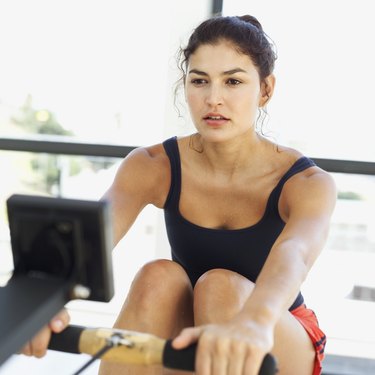
Cable rows require the use of a V-bar, and they are performed from a seated position on a low pulley machine. As you pull the bar toward your gut, you bend your elbow and shoulder joints. This in turn causes you to work multiple muscles at the same time. Compound exercises such as this lead to fast gains in size and strength.
Latissimus Dorsi
Video of the Day
The main muscle targeted with the cable row is the latissimus dorsi. This muscle starts in the lower back and runs at an angle toward the upper back, where it ends under the shoulder blade. Any time you pull a bar, dumbbell, barbell or some other weight toward your body, you activate this muscle. Well-defined lats give the back a "V" shape.
Video of the Day
Rhomboids
The rhomboids minor and major rest between the shoulder blades. You activate these muscles when you squeeze your shoulder blades together. This takes place when you pull the bar to your stomach during a cable row.
Trapezius
The trapezius is another large back muscle. It starts at the base of the skull and runs into the mid back and over the collar bones. Because of its size, the trapezius has upper, middle and lower fibers that often are targeted independently in workouts. The cable row places the most emphasis on the middle and lower fibers. An exercise such as an upright row or shrug taxes the upper fibers.
Biceps
The biceps muscle contains two parts -- the brachialis and biceps brachii. The biceps brachii has a long and short head and is clearly visible on the front of the upper arm. The brachialis sits behind the biceps brachii. Both muscles function to flex the elbow. This takes place when you bend your elbow and reduce the angle between your humerus and forearm. You perform this motion as you pull the bar in toward your body.
Erector Spinae
The erector spinae is a long strip of muscles that spans the length of the vertebral column and ends in the lower back. You activate this muscle group during back extension. This takes place when you bend at the waist and move your torso backward. During a cable row, you extend your back and hold it in this position throughout the exercise. This causes you to continually contract your erector spinae to maintain spinal stability.
Abs
The rectus abdominis, transverse abdominis and obliques all make up the abdominal wall. The rectus abdominis is the large muscle in the middle of the stomach. The transverse abdominis is deep inside the stomach and the obliques are on the sides of the ribs. You contract all of these muscles throughout a cable row to produce force and further keep your torso in good alignment.